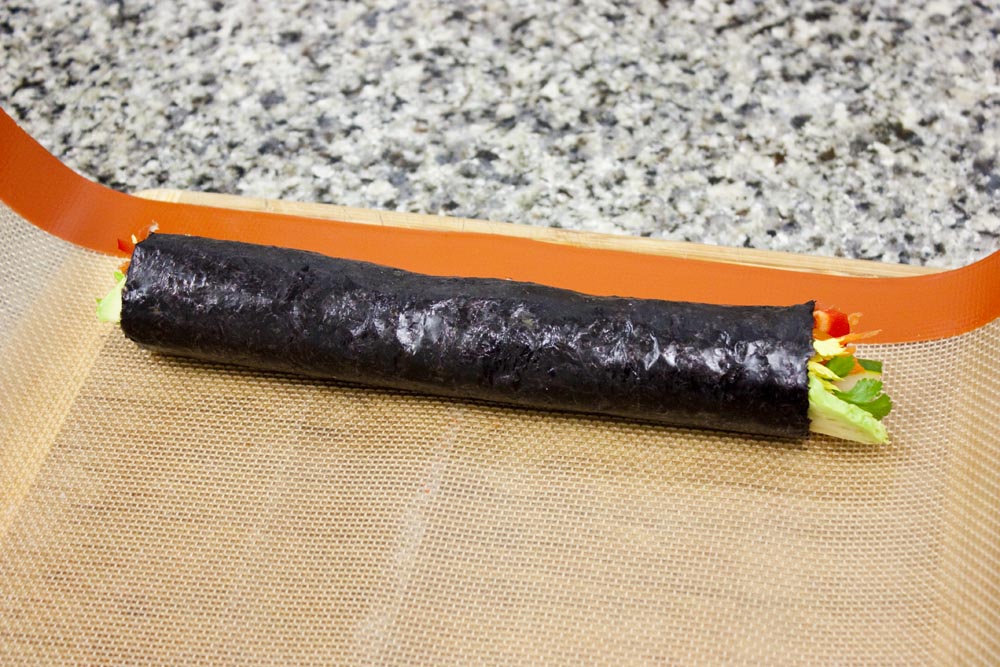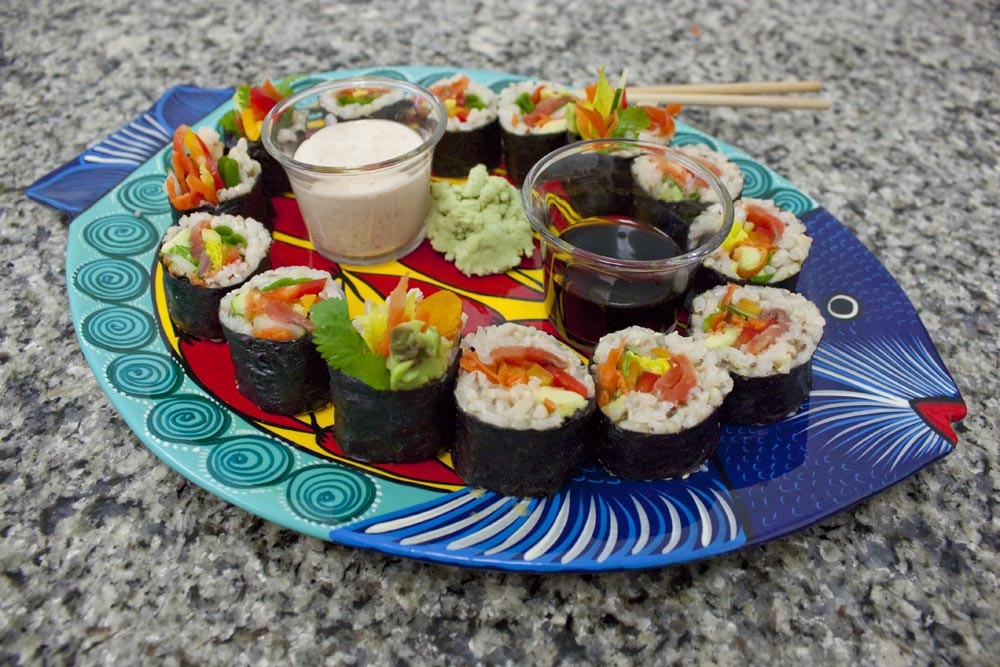
Beautiful and delicious sushi rolls are not difficult when you know how, even without special tools.
About sushi rolls
The traditional wrapper for all sushi rolls is a sheet of nori seaweed, commonly available in most food stores. Most nori sheets are sold in a standard size so the finished sushi roll can be cut into eight pieces. Nori sheets usually come in packs of eight or ten.
Some types of rice work better than others for sushi because they are starchier and therefore “sticky” rather than “fluffy” when cooked. Almost all sticky rices are white and finding sticky brown sushi rice can be difficult. There are a few ways to deal with this and still get great sushi rolls using the more nutritious whole grain brown rices available at most stores. Longer grain rice varieties tend to be starchier and stickier. Stirring the rice during the cooking process releases more starch. Using a little extra cooking liquid and extending the cooking time helps make brown rice stickier. I also like to add some chia seeds about halfway through the cooking time to make a stickier finished rice. Stickiness is not much of an issue if the sushi is rolled with the rice on the inside. If the rice is intended to coat the outside of the sushi rolls, it must be sticky enough to adhere to the nori sheet and to itself.
These sushi rolls are made with southwestern gravlox and vegetables, served with wasabi, vegetarian soy sauce and ginger-red chile mayonnaise. It is very easy to make vegan sushi rolls by using only fresh vegetables and substituting Vegennaise for the mayonnaise. Any other very fresh raw or cooked fish can be used in place of the gravlox. Tempura shrimp, salmon, crab and tuna are all popular fish choices for sushi rolls.
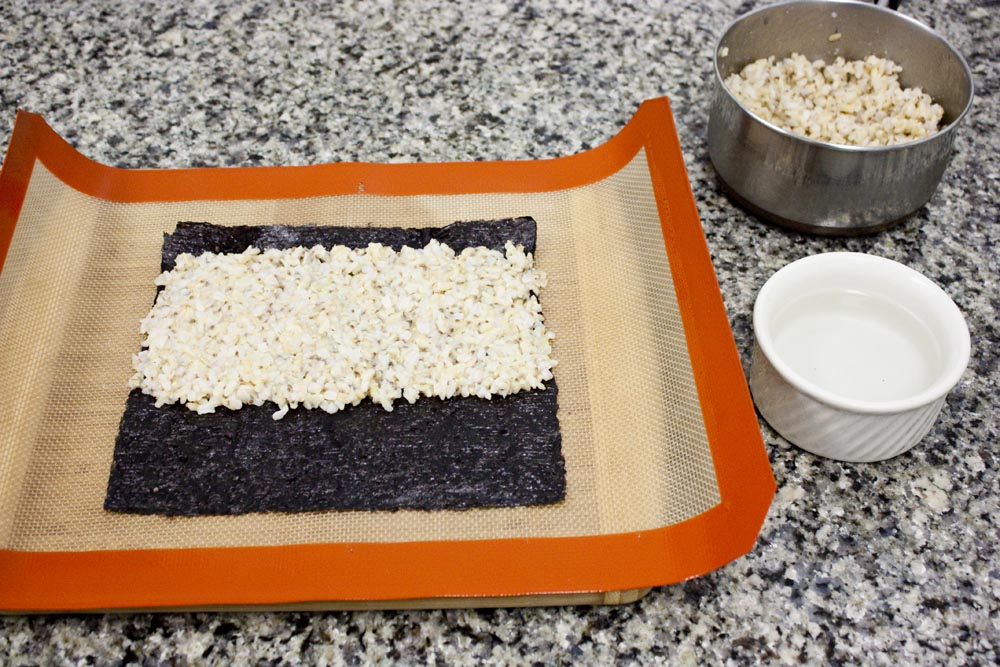
A silicone baking mat makes rice-on-the-outside sushi rolls easier because the rice won’t stick to the mat. A small bowl of water keeps rice from sticking to your fingers and helps seal the rolls.
Making sushi rolls is much easier than most people think. A bamboo sushi roller makes tight rolls a little easier but is not necessary for success. A non-stick silicone baking sheet makes rolling rice-on-the-outside rolls more foolproof, but again is not necessary. The only essential equipment is a sharp knife and a cutting board.
Ingredients
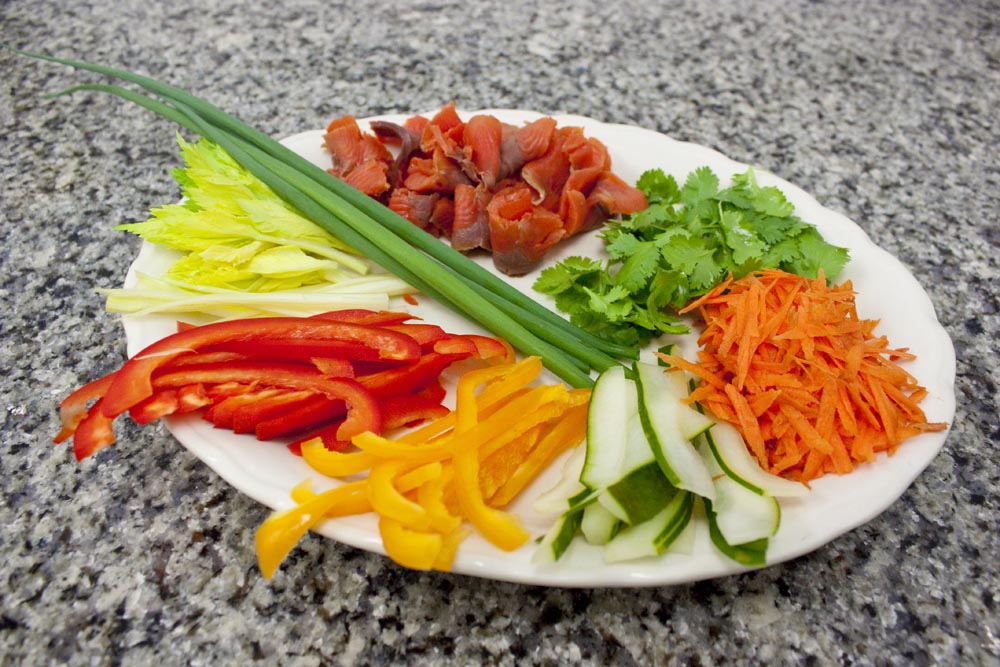
For these sushi rolls I used thin sliced southwestern gravlox, green onions, red and yellow bell pepper, cucumber, celery and celery leaves, carrot, fresh cilantro leaves and avocado.
For the sushi rolls:
nori seaweed sheets, 1 for each roll cooked brown sticky rice, 1/4-1/2 cup per roll
thin sliced southwestern gravlox or other fish of choice bell pepper of choice, thin sliced
cucumber, halved,seeded and thin sliced celery, thin sliced and including the leaves
carrot, shredded green onion, whole leaves or chopped
fresh cilantro, whole leave picked off the stem avocado, thin sliced
For the sauces:
mayonnaise, red chile sauce, fresh ginger root and honey
wasabi horseradish powder and water
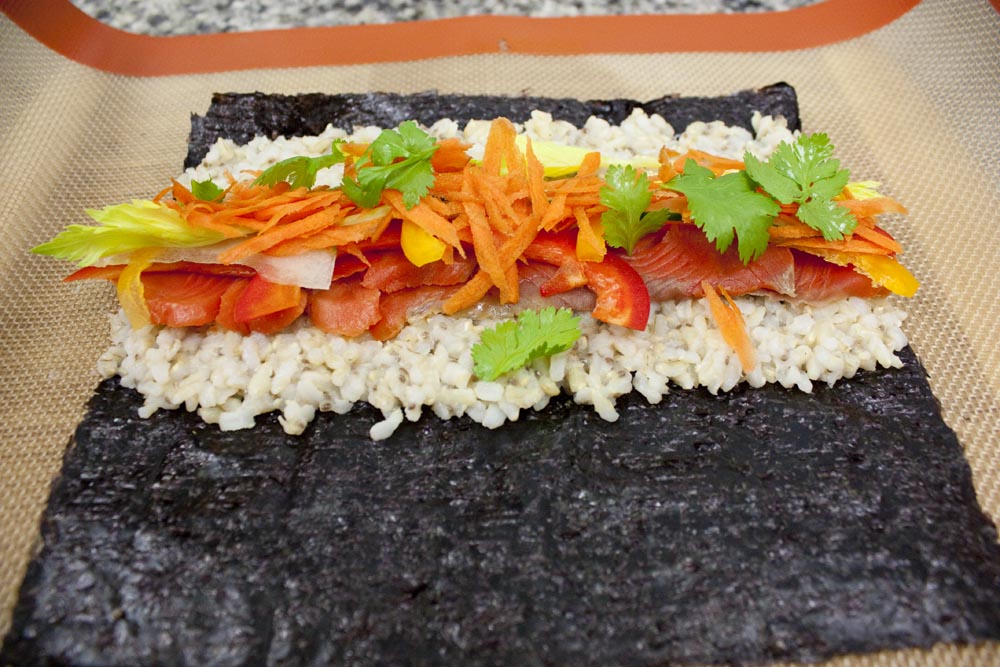
The sushi roll filling ingredients are placed on the rice, or on the bare nori on the opposite side from the rice, depending on whether the rice will be on the inside or the outside of the finished roll.
Preparation
1. Cooked the rice without oil, cool and toss with a little mirin rice wine vinegar
2. Get a small bowl of water to wet fingers when handling the rice and to seal the nori when rolling
3. Cut all of the filling ingredients
4. Lay out the first nori seaweed sheet with the rough side up and shiny side down(this allows the rice to adhere)
5. Wet fingers and spread/press out enough rice to cover about half of the nori. Leave 1/2″-3/4″ of exposed nori on the edge for sealing the finished roll.
6. Place enough of each ingredient on the edge of rice in the center of the nori sheet so that every slice will have some of everything. The amount will vary with the exact size of the nori sheet, the amount of rice and how large the fillings are cut. Go light as it is easy to overfill and get rolls that will not close or cannot be rolled tightly enough(sloppy to eat).
7. With the rice closest to you, pull the bare nori over the filling ingredients and carefully bunch up the filling as tightly as possible. This is similar to using a tortilla to make a burrito or lunch wrap. It is alright to have fillings hanging out the ends of the roll.
8. Wet one fingertip in the water and use it to wet the thin strip of exposed nori along the edge with the rice.
9. Roll up the nori and filling as tightly as possible and make sure the wet edge is flat when you get to the end. Place the finished roll aside, seam side down, while rolling the rest of the sushi.
10. When all of the sushi rolls are ready, start cutting them, starting with the first one rolled. I cut each roll into 6-10 pieces depending on the size of the nori sheets and how much rice and filling was used. For serving, the pieces can be arranged as shown and served with wasabi and sauces on the side or they can be left in a roll with the sauces drizzled over the top. Rolls can also be slightly moistened and rolled in sesame seeds before cutting, if desired.
11. For rice-on-the-outside sushi rolls, the process is the same except the nori sheet is flipped over after the rice is packed onto it. The filling are placed on the bare nori on the opposite side of the center edge of the rice.
Notes
Most common sauces for sushi rolls use mayonnaise as a base. I like to place mayonnaise, red chile sauce, fresh ginger root and honey in a food processor and run it until the sauce is smooth. Green fermented hot sauce makes a good substitute for the red chile sauce, or use red pepper flakes or red chile powder instead. Vegan versions can be made with Vegennaise in place of the mayonnaise.
Wasabi is almost always served with any sushi. Dry wasabi horseradish powder is mixed with water to get the desired consistency. A little soy sauce and/or mustard can also be added for extra flavor.
For vegans, vegetarian soy sauce is readily available in most markets. It does not contain any fish products and is also usually gluten-free.
Other vegetables commonly used for sushi rolls include steamed asparagus, shredded beets or parsnips, lettuce or spinach and just about anything else you might have on hand and want to use. Fish roe is often used in the roll filling and also as a garnish on top of the finished roll. Sushi can part of any healthy whole food diet and with just a little care can be made vegan and/or raw.


